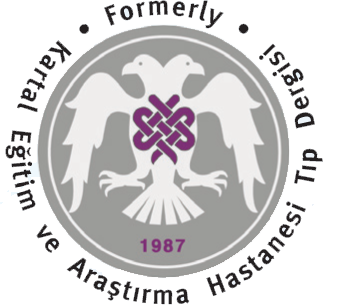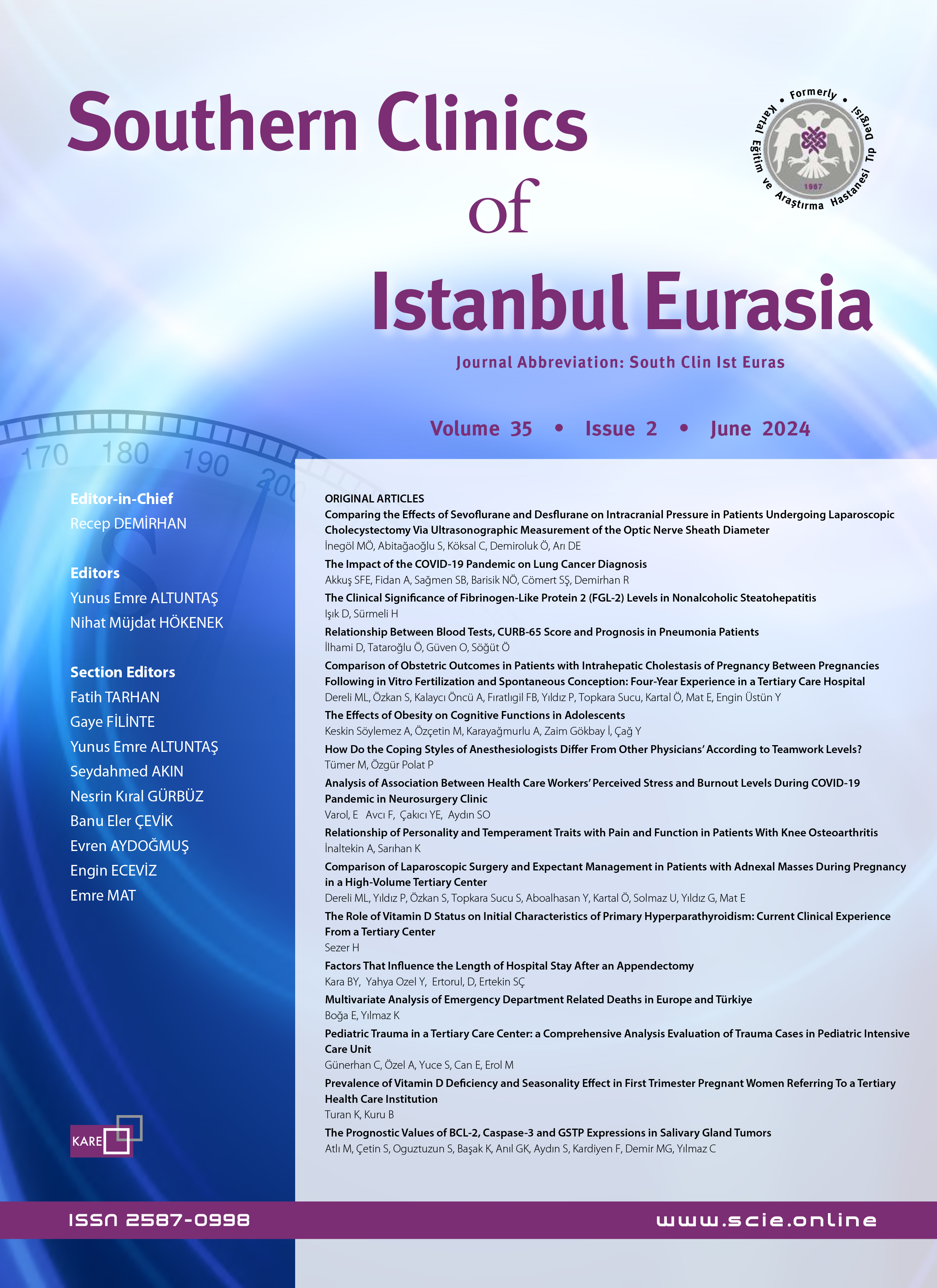Volume: 18 Issue: 2 - 2007
| RESEARCH ARTICLE | |
| 1. | Results Of Surgıcally Managed Intra-Artıcular Calcaneal Fractures Ufuk Özkaya, Yavuz Kabukcuoğlu, Atilla Sancar Parmaksızoğlu, Ayhan Kılıç, Sami Sökücü, Seçkin Baslıgan Pages 57 - 63 OBJECTIVE: Management and postoperative rehabilitation programme of intraarticular calcaneus fractures are controversial. The purpose of this study was to retrospectively evaluate the radiological and clinical results of patients with intraarticular calcaneal fractures managed with open reduction and internal fixation using locking plates. Fifteen calcaneal fractures of 13 patients who were operated in our clinic between 2003-2005 were included in the study. There were 10 male and 3 female patients with an average age 29 (range; 15-47) and the mean follow up period was 24 months (range; 16-38). Bohler angle and the reduction of the posterior articular facet were evaluated on preoperative, postoperative and follow-up radiographs. The fractures were classified according to the Sanders classification sysytem based on preoperative computerized tomographic evaluation. Bohler angle could be corrected to normal ranges in 11 of 15 patients (%75). Anatomic or near-anatomic reduction of posterior articular facet could be obtained in %73 of patients. Evaluation of function and pain were also done by using AOFAS score sheets; average AOFAS score was 80.1 (dağılım; 7297). Superficial wound infection in 2 patients and sural nerve neuropraxia which spontaneously healed in one patient was observed. Persistent hypoesthesia due to sural nerve damage occured in one other patient. Our conclusion is that surgical treatment of calcaneal intraarticular fractures, particularly Sanders type II and III is an effective and safe method. METHODS: RESULTS: CONCLUSION: |
| 2. | The Cases Admitted To Pediatric Emergency Department Due To Tick Bite Gülay Çiler Erdağ, Yasemin Akın, Esra Çetinkaya, Yelda Erkul, Gökçe Ergen, Gülnur Tokuç Pages 64 - 70 OBJECTIVE: The 542 children admitted to our pediatric emergency department between January 1st 2007 to September 1st 2007 were evaluated. Demographic, clinical and laboratory features were analysed retrospectively. The study group consisted of 304 (%56) male, 238 (%44) female children. The mean age of the patients was 7.1± 2,4 years (4 months-14 years); 23 (4.2%) of which were between 4-12 months of age, 51(9.3%) 1-2 years of age, 179 (33%) 3-5 years, 216 (40%)6-10 years and 73 (13.5%) were between 11-14 years of age. Majority of cases were encountered during June, July and August. Regarding time of admittance to emergency department, 280 (51.6%) admitted in 24 hours, 44(8.2%) in 48 hours, 80(14.7) in 72 hours, 84(15.5) in 96 hours, 54(10%) in 120 hours. In 226 (42%) patients tick was removed at home and in 316(58%) at hospital. All patients were evaluated by complete blood count, biochemical tests and coagulation studies. Of the 542 patients; 19(3.5%) were hospitalized and their serum samples were collected for virus isolation. None of them received Ribavirin. Crimean-Congo haemorrhagic fever was not observed in any of the patients. In this study, we wanted to emphasize the frequency of tick bites and the high number of efforts to remove the tick at home. Although there are many educational efforts about CCHF in our country which is in endemic region for this disease, the importance of education of not only the medical staff but also the community should be stressed. METHODS: RESULTS: CONCLUSION: |
| 3. | Angıoectasıas In Upper And Lower Gastroıntestınal Endoscopıes Emel Ahıshalı, Oya Uygur Bayramiçli, Can Dolapçıoğlu, Reşat Dabak, Fidan Canan Çelik Yağan, Binnaz Çalışkan, Erdoğan Arslan Pages 71 - 76 OBJECTIVE: The vascular lesions of gastrointestinal tract are important since they may cause acute or chronic, overt or silent bleeding.Introduction of new imaging techniques have led to easier diagnosis of vascular lesions of gastrointestinal tract. In this study we evaluated the patient profile and the incidence and localization of angioectasis in upper and lower gastrointestinal endoscopies performed between January 2006 and July 2008 retrospectively. 2837 upper gastrointestinal and 1220 lower gastrointestinal endoscopies were performed. Angioectasias was discovered in 5 patients (% 0.17) in upper gastrointestinal endoscopies. Three of the patients were females (%60) and 2 (40%) males with a mean age of 56 years. One of the patients had four lesions in corpus, one patient had two lesions in corpus, one patient had one lesion in antrum and one lesion in corpus, one patient had one lesion in antrum, and the last had one lesion in antrum and another in bulbus while all the lesions were measuring less than 1 cm. In 1220 lower gastrointestinal endoscopies 7 patients(% 0.57) had angioectasias. Four females and 3 males with a mean age of 52 years were identified. Angioectasias were in descending colon in two patient, in caecum in another, in sigmoid colon in another and were measuring equal or less than 1 cm. Only one patient had an angioectasia as large as 2 cm in caecum. In rectosigmoidoscopy we found an angioectasia in rectum in one patient and in sigmoid colon and rectum in the second patient each measuring equal or less than 1 cm. Angioectasias are rare in gastrointestinal system. In endoscopies done for indications other than bleeding, it is even more rare. Although angioectasias are reported to be more in the right hemicolon, it can also appear in left hemicolon as in our study. METHODS: RESULTS: CONCLUSION: |
| 4. | Our Results With Tension-Band-Wiring Technique In The Management Of Displaced Olecranon Fractures Ufuk Özkaya, Yavuz Kabukcuoğlu, Atilla Sancar Parmaksızoğlu, Murat Gül, Sedat Yeniocak, Ümit Özdoğan Pages 77 - 82 OBJECTIVE: Displaced fractures of the olecranon are almost always managed surgically. The aim of this study was to retrospectively evaluate the results of patients with displaced olecranon fractures who had been operated with tension band wiring method and to understand the subjective complaints and factors influencing the overall functional outcomes. Twenty eight patients who had been operated at our clinic for displaced olecranon fractures between 2001-2005 with at least one year of follow up have been retrospectively evaluated. Eighteen of the patients were male and 10 were female. The mean age of the patients was 37 (range;16-58) and the mean follow up was 32 months (range; 13-62). Four patients had Gustillo-Anderson Type I and one patient had Gustillo-Anderson Type II open fracture. Schatzker-Schmeling morphological fracture classification was used. The patients were radiologically evaluated for the presence of any articular step off or any degenerative changes, and were clinically evaluated according to the Broberg - Morrey index scores; operated side elbow range of motions were compared with the contralateral extremity. All cases had a solid union of the fracture. Degenerative changes of the elbow joint at the varying degrees were observed in 10 (%36) of the patients and an average of 10° (range; 5-12) loss of elbow motion was observed in the study. According to the Broberg Morrey classification, 21 patients (%75) had perfect or good, 6 patients (%21) had fair and one patient (%4) had poor result. The retrospective evaluation of the patients with fair and poor results showed that these fractures were high energy, unstable, comminuted fractures of whom postoperative rehabilitation program could not be started immediately. Modified tension band wiring method with good surgical technique in combination with early postoperative rehabilitation seemed to be effective on overall functional results of stable displaced olecranon fractures. METHODS: RESULTS: CONCLUSION: |
| CASE REPORT | |
| 5. | Carbon Monoxide Intoxication and Hyperbaric Oxygenation Elif Atar, Tamer Kuzucuoğlu, Müjge Yücekaya, Kübra Ömeroğlu, Oğuzhan Kılavuz, Burhanettin Irlat Pages 83 - 88 Case I: 35 year old male patient with closed concious was brought to hospital emergency service by his relatives.İn first examination;general condition was bad,pupil light reflex was +/+, eyelash reflex was existing.Heart sounds were rithmic, tension arterial (TA): 110/70 mmHg, heart rate (HR): 121/min. Spontaneus respiration was existing and there were bilateral diffuse roncuses by listening lungs. Carboxy hemoglobine (COHb) was founded %56,3 in labrotory analysis. In neurological examination, GCS was evaluated as 3. Patient was intubed and taken to the intensive care unit. He connected to the respirator as, Tidal volume: 5ml/kg, frequency: 12/min, PEEP: 5 cmH2O, PSV: 15 mbar, FİO2: %100 in SİMV+ PSV mode. Patological finding wasnt determined in Cranial tomographie(CT).The patient was sent to hyperbaric oxygenation treatment in first 6 hours of taking dose. Hyperbaric O2 was applied 2 times.According to decreasing of COHb to % 1,4 in blood gases value and recovering of the blood gases into normal, the patient was taken to the CPAP mode at first,then easy breath tried at the end of the 4th day.He was extubed in 4th day and sent to the related clinic with a good health. Case II: 19 year old female patient was brought to emergency service with the conscious changes and unoriented motions because of the poisoning from the gases that pass out from the stove. İn first examination; general condition was average,pupil light reflex was +/+, eyelash reflex was existing.Heart sounds were ritmic, TA: 120/70 mmHg, KTA: 70/min.Spontaneus respiration was existing and lung sounds were bilateral equal to listening and natural. Carboxy hemoglobine (COHb) level was founded %34,6 in labarotory analysis.In neurological examination GCS was evaluated as 15 and then patient was followed by a mask with %100 O2 and taken to the intensive care unit. She was sent to hyperbaric oxygenation in the first day of taking. Hyperbaric O2 was applied one time. Because of the blood gases value recovered to the normal level, the patient was sent to the related clinic with a good health at the end of the 2 nd day. As a result, administration of hyperoxygenisaton in early period and begining to the hyperbaric O2 treatment in acute period must be remembered as an important application for mortality and also preventing of neurophysicological sequels that have a probability of being in post period. |
| 6. | Chondroid Syringoma Of The Upper Lip: A Report Of A Case Mustafa Karaca, Aykut Mısırlıoğlu, Ali Dursun Kan, Tayfun Aköz Pages 89 - 92 Chondroid syringoma is a rare tumor which is derived from the sweat glands. It is usually encountered in the sixth or seventh decade of life. Since it is rare and has no spesific macroscopic appearance, it may be confused with the other frequent skin lesions. In this article, a case of a 37 year-old male patient who had a chondroid syringoma on his upper lip was presented and the literature about the diagnosis and the tretment of this rare tumor is rewieved. |
| 7. | Osteochondroma Orıgınatıng From A Rıb: Case Report Recep Demirhan, Burak Onan, Kürşat Öz, Güven Bulut, Alpaslan Mayadağlı Pages 93 - 96 Osteochondroma is a frequently seen primary tumuor of skeletal system. This pathology is usually observed between first and third decade, and generally originates from cartilaginous part of the long bones. Rarely skull base, columna vertabrales, ribs, scapula and pelvic bones can be involved. A 10-year-male child was diagnosed as having a mass on the right third rib. He underwent resection of the mass and the third rib through a right axillary thoracotomy. Pathologic evaluation of the lesion revealed the diagnosis of osteochondroma. The patient was observed for one year with a favorable outcome after surgery. This report presents a rare pathology of an osteochondroma originating from a rib in the view of the literature. |
| 8. | Percutenous Draınage Of Posttraumatıc Pseudocyst Of The Spleen: Case Report Barış Tüzün, Feyyaz Onuray, Murat Çağ, Levent Kaptanoğlu, Nimet Süslü, Erhan Tunçay, Esra Onuray, Selahattin Vural Pages 97 - 100 Secondary cysts of the spleen are rare lesions which can occur following blunt traumas. Differential diagnosis should be made with true cysts of the spleen, pancreatic pseudocysts, simple liver cysts of the left lateral segment and hydatid cysts. Splenectomy is surgical choice for the treatment of symptomatic or complicated cysts. Partial decapsulation and partial splenectomy are other methods. Percutaneous drainage is mostly comfortable for the patient. We present a case of posttraumatic, symptomatic pseudocyst which is over 20 cm. in diameter.The cyst has been drained percutaneously without any complication and no recurrens was detected. |
| REVIEW | |
| 9. | İntoksikasyonlara Güncel Yaklaşım Gülten Arslan, Kemal Tural, Yaman Özyurt, Hüsnü Süslü, Tamer Kuzucuoğlu Pages 101 - 107 Abstract | |



















